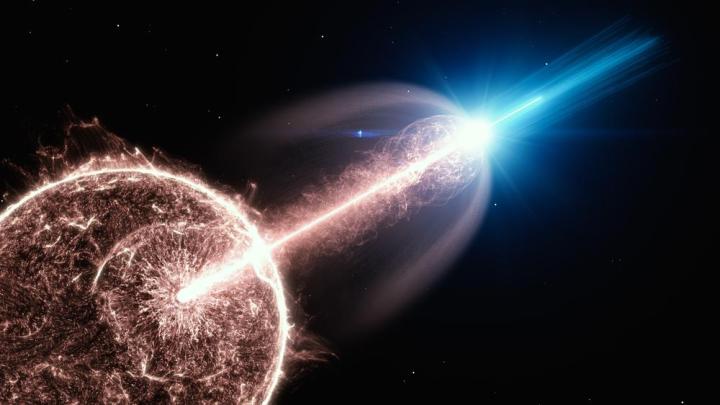
When you think of the most dramatic events in the universe, you might think about stars going supernova or about black holes colliding and sending ripples through spacetime. But the most powerful explosions we know of are something more specific which we barely understand: Gamma-ray bursts. Lasting anywhere from milliseconds to hours, these bursts are a million trillion times as bright as the sun, which means they give out more energy in the few seconds they typically last than the sun will give out over its entire 10-billion-year life.
It’s thought that these events happen when an extremely massive star that is rotating rapidly implodes and forms a new black hole. So they are related to supernovas, but not all supernovas produce them, and researchers aren’t sure why.
Now, scientists from the German research center Deutsches Elektronen-Synchrotron (DESY) have observed one of these gamma-ray bursts “in our cosmic backyard,” and their observations challenge established theories about how these epic events occur.
In August 2019, a gamma-ray burst named GRB 190829A was detected one billion light-years away, which is around 20 times closer than these events are typically observed. The DESY team jumped at the chance to observe such an event so relatively close and used an instrument called the High Energy Stereoscopic System (HESS) in an observatory in Namibia to take a deeper look at the burst’s afterglow.
“We were really sitting in the front row when this gamma-ray burst happened,” explained co-author Andrew Taylor from DESY. “We could observe the afterglow for several days and to unprecedented gamma-ray energies.”
Being so close by allowed the team to take very detailed readings of the energy given off by the massive explosion. “We could determine GRB 190829A’s spectrum up to an energy of 3.3 tera-electronvolts, that’s about a trillion times as energetic as the photons of visible light,” explained co-author Edna Ruiz-Velasco from the Max Planck Institute for Nuclear Physics in Heidelberg. “This is what’s so exceptional about this gamma-ray burst — it happened in our cosmic backyard where the very-high-energy photons were not absorbed in collisions with background light on their way to Earth, as it happens over larger distances in the cosmos.”
And the results were surprising. Current theories predict that two types of emissions would be seen from such an event, coming from two separate sources: X-rays and high-energy gamma-rays. But observing this burst, the researchers saw both X-rays and gamma-rays fading in sync, strongly suggesting that both emission types came from the same source.
That means that our current assumptions about how these enormous explosions occur might well be wrong. But the researchers are hopeful that we’ll be able to detect more such bursts using upcoming instruments like the Cherenkov Telescope Array, which will help explain how these universe-shaking events unfold.
The results are published in the journal Science.



